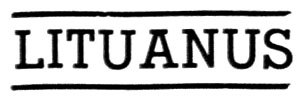
Managing Editor P. V. Vygantas
 |
www.lituanus.org |
|
Copyright
© 1957 Lithuanian
Students Association, Inc.
March,
1957 No.2(10)
Managing Editor P. V. Vygantas |
|
Book review
AN
ETYMOLOGICAL DICTIONARY OF
LITHUANIAN
Dr.
ANTANAS KLIMAS
It is a well known fact that Lithuanian is one of the most archaic idioms of the Indo-European family of languages. It has preserved many ancient features in its phonetics, morphology and accentuation. Any linguist either in Baltic or Slavic studies or in the broader field of Indo-European linguistics has to be acqainted with the works in the field of Lithuanian.
Much has been done in the last hundred years in Baltic linguistics by various scholars, but most of this has been published in books dealing with various problems and in many articles in widely scattered philological journals and publications. To this day, Lithuanian does not have the three standard works which would cover the whole field in the manner that has been adopted for most of the Indo-European languages, i.e., a historical grammar (phonetics, morphology, word formation), an etymological dictionary (word origins), and a complete dictionary of the language like the Oxford Dictionary of the English language. At present a complete dictionary of Lithuanian is being published, but it will be many years, and perhaps several generations, before it is completed. A full historical grammar of Lithuanian is also "in the mill," but nobody knows when it will be completed. Therefore it is a very welcome fact that a Lithuanian etymological dictionary has been appearing in individual issues (German: Lieferun-gen) since 1955. It is already near the halfway mark in printed form, and the whole manuscript is ready for printing.
This work, which will be completed in a year or two, has been written by the prominent linguist Dr. Ernst Fraenkel, professor emeritus of Indo-European philology at the University of Hamburg, formerly professor at the University of Kiel. Dr. William R. Schmalstieg of the University of Kentucky writes:
"The publication of a Lithuanian etymological dictionary will satisfy a need which has long been felt both in Baltic comparative linguistics and the more general Indo-European field as well. All who are interested in either of these fields must be thankful to Ernst Fraenkel, who in the writing of this dictionary has brought to bear his abundant knowledge of the Baltic languages and his wide acquaintance with Baltic linguistic literature. His achievement is particularly great in that it is largely a pioneering work in this field." (Word, Dec. 1956, p. 331).
This dictionary is written in German and published by Carl Winter in Heidelberg and Van-denhoeck-Ruprecht in Gottin-gen. Its title is "Litauisches ety-mologisches Woerterbuch." It appears in issues of 80 pages each. So far, five issues have appeared (aba - m), 400 large, doublecolumn, small-print pages. The dictionary, when completed, will be about 9-10 issues, ca. 800 pages.
In his introduction, Professor Fraenkel says he started to work on the dictionary in 1947, although we know he has been collecting material for this work for many years. He does not include all Lithuanian words, leaving out primarily the ono-motopoetic ones and also many loanwords. Quite a few borrowings, however, are given in the dictionary. For the explanation of the origin of these words he relies primarily on two works in this field: Pranas Skardžius, "Die slavischen Lehnwoerter im Altlitauischen," Kaunas, 1931, and K. Alminauskis, "Die Ger-manismen des Litauischen, I," Kaunas, 1934.
Of the dictionaries used, Professor Fraenkel mentions the large-scale "Lietuvių kalbos žodynas" (Dictionary of the Lithuanian Language), which has complete material up to f. He also uses the first issue of the dictionary of Būga, Juškevičius, "Litowskij slovar," the Nieder-mann-Senn-Brender-Calys dictionary of contemporary written Lithuanian (in its third volume), Sereiskis' Lithuanian - Russian dictionary and also "Dabartines lietuvių kalbos žodynas" (Dictionary of Contemporary Lithuanian), edited by Balčikonis. A multitude of books, articles, publications, dictionaries and grammars on Indo-European languages are used very extensively, with references to all available works of any importance, works written in practically all European languages.
In presenting his material, Professor Fraenkel holds more to the classical method of comparative linguistics, not mentioning at all different and still-controversial theories of the modern structural linguistics, such as the laryngeal and similar theories. Thus he is true to the tradition of the standard etymological dictionaries such as Feist's "English Etymological Dictionary." After the Lithuanian words he lists Latvian and Old Prussian entries, then Slavic forms, arranging them from east to west, i.e., he starts with Old Indie (Sanskrit) forms and ends up with Old Icelandic or Celtic forms. Tokharian and Hit-tite forms are usually given last.
It is not the intention of this short article to review this work thoroughly, rather merely to provide information concerning its appearance. When completed it will certainly stand as one of the basic works in Baltic and Indo-European linguistics, as a monument to Professor Fraen-kel's scholarly zeal.
The above-quoted Dr. Schmal-stieg states in his review of the first three issues of the dictionary:
"With all its shortcomings, this dictionary represents an important and significant advance in the field of Baltic linguistics." (Loc. cit. 334).
Prof. Dr. Ernst Fraenkel, Li-tauisches etymologisches Woer-terbuch. Carl Winter, Heidelberg and Vandenhoeck - Ruprecht, Gottingen. In the series: Indo-germanische Bibliothek; 2. Rei-he: Woerterbuecher. Issues 1-5. 1955 ff.